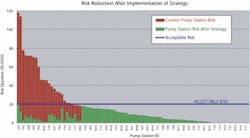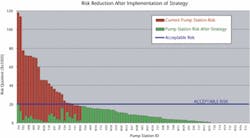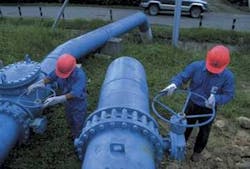Risk assessment key to cost-effective asset management
By Dr. Adrian Bowden
Management of risk is a factor that is often overlooked in establishing sound fiscal procedures. A strategic business risk assessment, expressed in easily understood financial terms, can be an effective tool when applied to the cost-effective management of assets.
Asset management and maintenance has always been a fundamental responsibility of local authorities and other service providers in the water industry. Although it is a major cost to the industry, appropriate spending is a necessity. Over the past decade, restrictions on rate increases and the ongoing commercialisation of these traditional services have significantly limited the funding available for maintaining water and wastewater infrastructure. Yet the demand for fiscal responsibility requires that public and private companies continue to tightly manage expenditures on asset management.
To balance these conflicting strictures, managers must be able to make cost-effective decisions about how and where to spend their asset-management budget and to justify their decisions. The RISQUE method, a systematic strategic business risk assessment approach, prioritises asset-management expenditures based on financial risk. It can be applied to any business, but it is well suited to the water industry. It has been used successfully in a wide range of applications, including comparative financial risk assessments of project options, determination of the financial risk of acquisitions, financial reporting of contingent liability, developing financial assurance bonds, and quantifying social and environmental issues.
Understanding risk
The most widely used definition of risk in this context is "the product of the likelihood of an event occurring and the adverse effect its occurrence will have on corporate objectives." Risk management, in turn, is "the culture, processes and structures that are directed towards the effective management of potential opportunities and adverse effects." Applied to asset management, this concept requires that focus be placed on high-risk assets whose failure would most adversely affect a business in a manner that makes the best use of available financial resources and/or provides opportunities for cost savings.
A corporation's business-risk portfolio may include, for example, events with the potential for adverse effects on that company's investments, revenue, reputation, technological capability, security, and legal liabilities. It also applies to the welfare of staff or stakeholders, occupational health and safety, natural environment, political environment and property. The methods of estimating losses associated with several of these components in financial terms are well established, and the process is relatively straightforward for issues such as property damage, loss of revenue, and some aspects of environmental remediation and consequential loss.
By comparison, assessment of indirect risks, such as social issues, damage to reputation, and community protest, have typically been treated as non-quantifiable and therefore difficult to incorporate into financial assessments of consequential impact. The difficulty of transforming these intangible risks into an equivalent measure of that used for technical risks usually creates a stumbling block when trying to include them in a risk assessment. Nevertheless, these factors need to be accounted for when assessing whole-of-business risk.
Despite prior doubts, virtually all so-called intangible risks can be expressed in financial terms. The key is to approach the problem with a holistic understanding of potential scenarios and focus on defining consequences. By breaking the issue down into its component parts, secondary consequences that are quantifiable can be identified. For example, share price can provide a direct measure of corporate reputation, while product boycott and trade disruptions may be taken as measures of community dissatisfaction. This quantitative approach was applied in a risk assessment conducted for Metrowater pumping stations in Auckland City, New Zealand, which included the assessment of social and political risks in addition to those associated with the physical works.
Metrowater pumping stations
Metrowater owns and operates 102 wastewater pump stations within Auckland City. The company identified the pump stations as critical assets and commissioned a quantitative risk analysis to evaluate and develop a management strategy in a consistent manner. Working closely with key Metrowater staff members, a team from Business Risk Strategies, a division of URS Corporation, identified and quantified risks associated with the sewage pump stations. Then, a relatively simple risk assessment process was initiated that met Metrowater's corporate objective of developing and implementing a risk-based asset management program.
The direct costs to Metrowater of pump station failures were relatively minor compared to those associated with intangible consequences. The potential major impacts of sewage overflows fell into three broad categories: environmental damage, community response and politician reaction. Metrowater had already recognised those possible consequences and had implemented a number of management actions to reduce exposure to failure. There remained, however, a residual risk of failures leading to substantial sewage overflows in the future.
The panel began by grouping pump stations into four categories depending on their degree of environmental sensitivity. For each station, the panel then estimated the likelihood of a range of potential failure trigger mechanisms that could cause a pump station failure. The expected impacts of sewage overflows and their subsequent consequences (in this case financial) were determined according to the sensitivity of each receiving environment. The panel also evaluated the severity and likelihood of causing each of the potential impacts within each receiving environment.
From these data, a risk profile was developed that ranked the pump stations in descending order of risk. The profile showed that the nine highest risk stations were responsible for 43% of the total risk, with 72% of the total risk posed by 22 pump stations. The remaining pump stations accounted for only 30% of the total risk.
Management strategy
Once the risk assessment results were available, the panel developed the pump station risk-management strategy. The information derived was used to:
• develop risk-acceptance criteria;
• identify risk-treatment options to reduce risk to the acceptable levels;
• determine the extent to which the strategy reduces overall risk; and
• demonstrate the benefits created by implementation of the strategy.
Large reductions in risk can be achieved relatively early in the risk-management process, but subsequent reductions diminish progressively. There finally becomes a point at which the cost of risk reduction is greater than the potential exposure presented by residual corporate risk. In Metrowater's case, an approach based on the company's perception of risk and its level of comfort with respect to specific pump stations was developed.
The panel indicated that the perceived risk posed by the lowest-risk pump station was considered to be clearly acceptable. As each ascending category of risk was considered, three groups of acceptability were identified: pump stations with clearly acceptable, marginally acceptable, and unacceptable risk. The acceptability criterion was set at US$ 20,000 for the highest of the clearly acceptable group. Subsequent reviews of the risk-management strategy might indicate that a different risk target would be more appropriate.
Risk treatment options and reductions
Risk treatment seeks to reduce the likelihood of an event, such as a pump station failure, its consequences or both. The panel identified engineering solutions — increasing pump station storage capacity, improving monitoring, installing audible alarms, upgrading pumps, and installing bollards — that would be most appropriate in reducing the chance of failure. It also cited community-related actions, such as education and public involvement, as ways of handing the consequences of failure.
Risk-reduction measures began with highest-risk pump stations and working down, in each instance considering the actions that should be taken to reduce risk to the acceptability criterion. For each pump station, the panel identified the main contributors to risk using the risk-assessment output data. It also identified the effects of actions on reducing pump-station risk and assessed the cost of carrying out the actions. Risk-reduction measures were added until the risk model showed the station to be at or below the acceptability criterion.
The cost-benefit analysis of Metrowater's risk-management program indicated that an expenditure of about US$ 1.2 million would effectively lay off around 40% of the current risk and reduce risk exposure by approximately US$ 9.4 million associated with the nine highest-risk stations. Expenditure of an additional US$ 300,000 would address the 16 next highest stations and reduce exposure by about another US$ 11.6 million.
The use of expert estimations of likelihood of occurrence and financial consequences can produce defensible financial risk data to support rational business decisions. A strategic business risk-assessment approach is based on sound, traditional probability techniques that incorporate uncertainty into the assessment. Its application to the water industry has proven to be both practical and cost-effective.
Author's note
Dr. Adrian Bowden, the senior principal in URS Corporation's Business Risk Strategies Division, is based in Melbourne, Australia.


